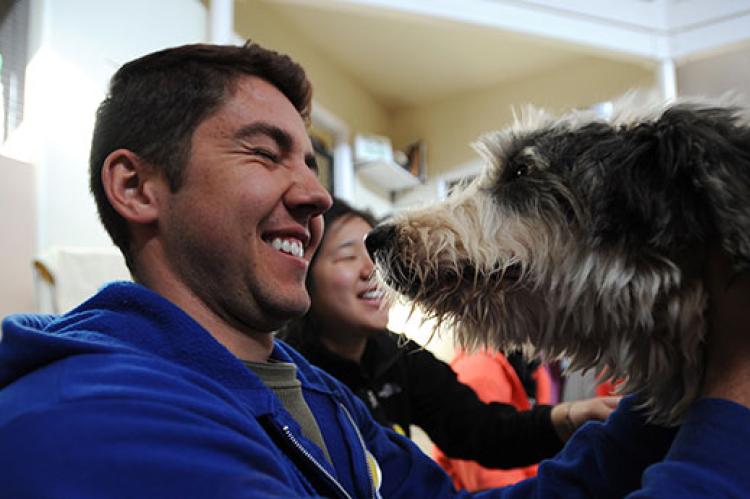Smelly Dog: Why Does My Dog Stink?

Veterinarians often get asked: “Why does my dog smell so bad?” People frequently place blame for a stinky dog on themselves, thinking they aren't caring for their pets properly. But in fact, there can be several reasons why some dogs smell bad — even after a bath — and some are related to the dog's health.
Common reasons why dogs smell bad
Some reasons for a dog's foul odor are obvious. Many dogs like to roll in poop and dead stuff. You might not witness the event, but the smell is unmistakable. Usually, giving the dog a good bath will solve the problems associated with rolling in smelly things.
Another unmistakable odor on dogs is skunk spray. There are skunk odor eliminators for dogs available, but a thorough bath to rinse the oils off the coat followed by some type of acidifying wash using diluted vinegar or tomato sauce can work. Be prepared for the scent to linger for a while though; you might not want your pup to sleep on the bed for a few weeks.
Then, of course, there can be other issues for why dogs smell bad that are not as easy to identify. The basics behind an odor from a dog's skin or coat are pretty straightforward. There is generally some type of infection, a change in the skin’s composition, or an alteration to the amount of secretions the skin produces. The difficulty is in trying to figure out exactly what the underlying disease process is that’s causing these skin changes and the subsequent doggy odor.
Dogs with allergies
Let’s start with one of the most common culprits for doggy odor: allergies. Allergies typically affect pets differently from the way they affect humans. In humans, allergies can cause itchy, watery eyes and sneezing, but in dogs, they often manifest themselves as problems with the skin.
Dogs can have allergies to something in their food or something in the environment. The allergens to which the dog is exposed cause an inflammatory response in the skin. And a whole cascade of events leads to the dog becoming very itchy and causing trauma to the skin from scratching and licking in an attempt to soothe the itch.
The result is skin changes that, when mild or present for a short period of time, often go unnoticed or untreated. If they persist or worsen, however, they cause the skin to become inflamed. The skin gets thicker, secondary infections develop, and then the skin produces increased amounts of secretions of oils and water.
You can see where this is heading. The thick skin, secretions, and infection all mix together to form a pretty stinky stew. Simply bathing the dog will not help — or at least it won’t help for long. The underlying disease or diseases need to be treated. Your veterinarian might prescribe things such as medicated baths, antibiotics, anti-inflammatory drugs, and primary treatment for the allergies such as a special diet or allergy shots.
Canine skin infections
Yeast infections are another common underlying problem that can lead to a stinky dog. Yeast is not a typical inhabitant of the skin, but given the right environment it can sure flourish there. Sometimes the yeast is localized to places such as skin folds or ears — places that stay dark and moist. Often, however, the yeast can infect a dog’s skin systemically. This is seen more in dogs who have had stress to their immune system, but any dog can develop these infections.
Once the yeast infection is diagnosed by your vet, treatment might include medicated baths and oral medication. Be patient, as this type of infection can take weeks or even months to clear up.
Seborrhea in dogs
Dogs with seborrhea have excessive scaling and flaking of the skin. The seborrhea might be dry and flaky or oily and greasy, and it is often worse in skin folds.
There are two forms of seborrhea, primary and secondary. With primary seborrhea, which is often breed-specific and starts at a young age, there is no identifiable underlying disease. Secondary seborrhea occurs when another disease causes excessive scaling and flaking of the skin. Hormonal changes, allergies, infections (from bacteria, fungus, or parasites), poor diet, obesity, and environmental factors such as temperature and humidity changes can all lead to secondary seborrhea.
Both primary and secondary seborrhea are treated with medicated baths, as well as treatment for any of the underlying problems mentioned above. There are other specific medications and supplements that can help, and treatment is tailored to the individual dog by a veterinarian.
So how can I help my smelly dog?
To sum up, you’ve probably noticed that bacterial and yeast infections and allergies are mentioned several times. The take-home point with skin disease and chronic odor in dogs is that many different problems can be at work all at once, throwing off the normal healthy balance in a dog’s skin. It can be time-consuming not only to diagnose but to treat successfully. A good outcome is highly dependent on working closely with your veterinarian, following their directions, and being very patient.